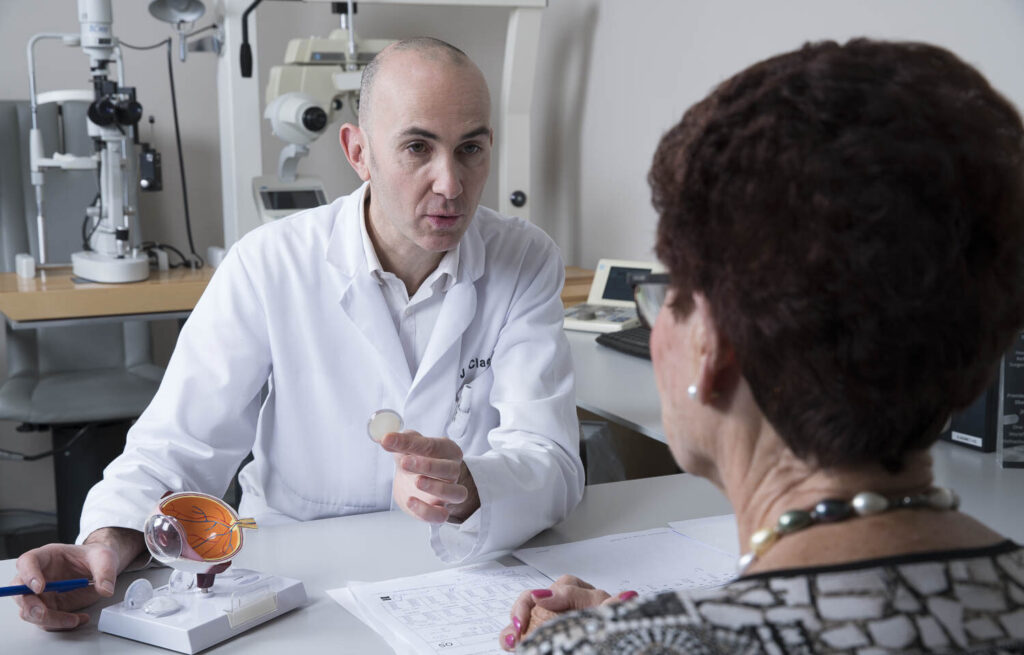Cataract
The following doctors on our team specialise in the treatment of cataract:
Dr. De Wilde, Dr. Vereecken, Dr. Mai and Dr. Tecim.
What is cataract?
Cataract is a clouding of your natural ocular lens. Normally, the lens ensures that a sharp image is projected onto the back of your retina. This gives you sharp vision. If you have cataracts, the lens becomes cloudy and your vision is blurred. Cataract occurs most often in people aged over 60, but it can also happen earlier and can develop over months or years.
Symptoms of cataract
- Blurred vision
- Double vision
- Changing vision after the age of 60 (e.g. the ability to read again without glasses)


Treatment of cataract
The only solution for cataract is an operation in which the natural cloudy lens is replaced by a clear artificial lens. We can carry out this operation under local anaesthesia. There are various techniques to remove the cloudy lens.
A cataract operation with lens replacement is the most common operation in Europe. The entire procedure takes less than a quarter of an hour. We use the latest and most advanced instruments for the procedure to guarantee optimal results. The incisions are so small (less than 3mm) that no stitches are needed.
Lens replacement with laser
As one of the few eye centres in Belgium, we are also able to offer laser-assisted cataract surgery without having to make an incision with a knife. A Catalys eye laser performs four treatments that were previously carried out by a surgeon. This way, the incisions in the cornea are made by the laser, as is the round opening in the capsular bag around the cloudy lens and the lens fragmentation. The laser can also correct cylinder divergences with great accuracy. There are sometimes specific indications that the cataract operation should be done with a laser, such as where the endothelial cells of the cornea are of very poor quality or if the anterior chamber of the eyeball is very narrow. Generally speaking, the laser is a bit safer and more precise than the human hand, and so there is also less chance of side effects.
The surgeon will discuss with you what the most suitable lens is (see below) as well as the best treatment method (with or without a laser) for you.
Stappen van een lensvervanging
Phaco-emulsification
Via a small incision, a hollow probe is introduced that vibrates at high speed. The lens with the cataract is broken down into tiny pieces with ultrasound waves, which are then sucked out through the probe. The rear part of the capsular bag remains intact.
Where the lens is replaced with a laser, this step is no longer done manually by the surgeon using a knife, but instead a laser is used to make an opening in the eye, after which the core of the lens is made fluid by the laser.
Inserting the lens implant
Via the same incision, a folded lens implant is inserted and placed in the empty lens capsular bag.
New, clear lens
Once the new, clear artificial lens is in place, the probe is removed. Because the incision is so small, no stitches are needed.
More information about lens replacement with Catalys laser:
Intake examination and the right lens implants for you
Based on the results of the examination and your own expectations and life situation, together you and your eye doctor will determine the most suitable lens implants. Our doctors can implant every type of lens.

- Standard, monofocal lens implant
- Comfort lens
- Multifocal lens
- Toric lens
If you have irregularities in the cornea (astigmatism, sphericity, etc.), these can be compensated for with a toric lens implant. Both monofocal and multifocal lenses are available in this form.
How much does a cataract treatment cost?
During the consultation, we will explain the costs of your specific treatment. The cost of a cataract operation depends on the choice of lens. This treatment is partially covered by medical insurance.
During the consultation, we give you all the necessary information about a cataract operation, how you have to prepare for it, and what aftercare is required.

